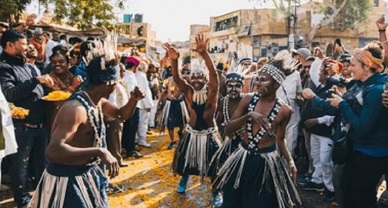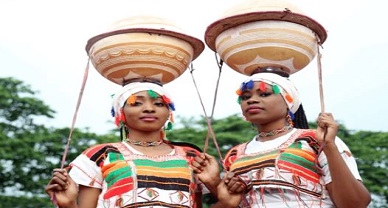Proselytization of Tribal in India and Measure to Prevent It
INTRODUCTION
Tribal communities since time immemorial always remained as ostracized groups in the Indian socio-economic as well as political system. However, the philosophy of SANATANA based on the oldest ever known books – ‘Vedas’ – states at first about five tribes that were (a) Yadu; (b) Turvasa; (c) Anu; (d) Druhyu; and (e) Puru.[i] It shows that tribes have played a crucial role in the political scenario of our nation since ancient times. Another instance that would be worth quoting to show the bravery of these tribal groups is ‘Ahoms’ defeating Mughals 17 times in the battle. Ahoms is a tribe that ruled Assam from the 13th century till the establishment of British rule.
After the establishment of British rule, tribal communities played a major role in facilitating the freedom struggle to gain independence. There are various popular uprisings such as Sambalpur Revolt, Kherwar Uprising, Santhal Rebellion, Tana Bhagat Rebellion, and various others that took place during the colonial era to kick out the Britishers from India by tribal communities.[ii] However, the post-independence governance does not find these rebellions important to put down in course-curriculum of history books so that each student might get aware of the struggle that these ostracized communities have laid by sacrificing their lives to gain independence from that dark rule.
The intention of Britishers was not only to plunder the wealth of glorious India but also want to keep Indians as their servants so that their rule last long. To achieve this, they first introduced the British English education system by butchering the Indian cultural education system based on gurukuls and Vedas. Further, another step to bolster the same was mass conversions. Britishers introduced Christian missionaries in India to obliterate the Hindu culture and traditions. Even after independence, such missionaries still reside in India and never give up any chance where they can convert the people of other religions. Considering the same, this article attempts to analyze the ongoing mass conversion of tribal communities in India. With the help of demographics and cases reported, the article substantiates its arguments and further delves into the legal resort available to tribal community members to prevent such mishaps.
PROSELYTIZATION IN INDIA: A MYTH OR REALITY?
After the establishment of the British Raj in India, it fought many battles and won the North-eastern parts of India, including Assam. After winning these areas, it started its proselytizing campaign to convert the Hindu Tribal groups into Christianity so that they can feel Britishers as a part of them instead of seeing them as foreigners ruling them. The result of which, Mizoram, Manipur, and Nagaland have now become almost entirely Christian states.[iii] Further, the imposition of the Inner Line Permit (ILPs) to restrict the population of the other parts of India from going to North-east India acted as a boon for Britishers. They allowed access of the North-east to the Christian missionaries that started their mass proselytizing campaigns and completely changed the demography of these states as well as tribals by destroying their culture and traditions.[iv]
As per the demographics, before the invasion of Islam, India was a well-established nation with Hindus (including Jain, Buddhist, and Sikhs) residing in it. After the Islamic invasions, forced mass conversions took place, and seeds of Islam got sown in India. Further, with the colonialization of India, Christianity got introduced in India. The mass-conversion programs first got unleashed on tribal communities as they were the illiterate persons who used to live in forests and not much aware of the politics going on in other parts of their nation.

As per the 1961 census, 89 percent of the tribals used to profess Hinduism, while the other five percent stated that they converted to Christianity.[v] The 2001 census stated that there are 8.43 crore tribals reside in India that got increased to 10.4 crores as per the 2011 census. The point that must attract your attention here is that the 2011 census also shows that Christians and Muslims are the fasted growing religions among tribals.[vi] The number of tribals who follow Christianity grown up by 63 percent from 63.90 lakh in 2001 to 1.03 crore in 2011, while the number of tribals who follow Islam has also shown growth by 51.6 % from 12.25 lakh to 18.58 lakh.[vii] It somehow raises the question that how such communities are increasing at such a greater pace than other religions.
Such questions also get bolstered when we take into account various media news and reports. Recently in 2018, sixteen Christians were arrested as they were trying to forcefully convert the tribal people living in Jharkhand. When the tribals came to know about their agenda, they held those Christians hostage for two days and later handed them to the police.[viii] Another instance is of Mathura, in Uttar Pradesh, where in a village of Scheduled Castes (SCs) and Scheduled Tribes (STs), seven Christian preachers were held for forcefully converting them[ix]. Such instances of forced proselytizing are common in the tribal sphere as Tribal groups lack education, awareness and being a vulnerable class gets lured by such preachers easily. It is easy to convert those tribal persons who are less in numbers or reside aloof from city areas in small villages, and their tribal culture is endangered i.e., on verge of getting extinct.[x] Thus, to cope up with this epidemic as well as protect the rich tradition and culture of tribals, various state governments formulated anti-forced conversion laws making it a penal provision for those who attempt to convert the vulnerable tribal people forcefully.
WHAT IS RICE BAG CONVERTS OR RICE CHRISTIANS?
The word ‘rice bag converts’ or ‘rice christians’ is used to refer to the people who convert to Christianity after getting induced by the Christian preachers on the pretext of material benefits. The Brewer’s Dictionary of Phrase and Fable defines Rice Christians as “Converts to Christianity for worldly benefits, such as a supply of rice to Indians. The profession of Christianity born of lucre, not faith.”[xi] The term “rice Christians” appears in the writings of William Dampier, an English explorer (and occasional privateer-pirate) who visited Indo-Pacific waters in the late 17th century. Dampier dismissively wrote of the French Catholic priests active at that time in Indo-china, opining that “alms of rice have converted more than their preaching.”[xii]
Thus, taking the benefit of poverty and hunger, Christians converted the people by inducing them. Rice Christians are most common in Asian countries, including Japan, China, and India. Tribals in India are also said ‘rice bag converts’ as Christian missionaries taking the benefit of their poverty and hunger provide them monetary assistance and food and make them convert into Christianity. Further, the ‘rice bag converts’ here are not only concerned with rice bags but also include other monetary assistance and material help.
HOW TO CURB SUCH PROSELYTIZING CAMPAIGNS
As stated above, that there are various states in India that have enforced such anti-forced conversion legislations. Primarily the states are Odisha, Madhya Pradesh, Arunachal Pradesh, Chhattisgarh, Gujarat, Himachal Pradesh, Jharkhand, Uttarakhand, and Uttar Pradesh.[xiii] Thus, one can go for legal resorts available under such acts to curb the ongoing campaigns. All of the legislation provides that if one converts someone or attempts to convert someone by force, fraud, and allurement, then he/she will face penal action against him.[xiv]
Another step to curb such campaigns can be done by creating awareness among the tribal communities about the same. The governments should attempt to spread the information and make tribals aware that if someone attempts to lure or convert them against their will, then there are legal resorts available that they can avail and make such person punish. One of the main reasons behind such conversions is allurement. Tribals being socially as well as economically vulnerable, fall into the trap of preachers who assure them that they will provide them monetary assistance or basic necessities not available to them. Thus, the government should formulate welfare schemes to make tribal people uplift and provide them access to basic necessities such as food, water, shelter, and clothing.
Even after 70 years of independence and formulation of several schemes, tribals are still vulnerable who lack basic necessities to live. Even though, in 1999, the Atal Bihari Vajpayee government established the Ministry of Tribal Affairs,[xv] the work of the ministry under the governments after the Atal Ji’s government was not up to the mark. It took nearly 52 years to establish a specific ministry for the welfare of tribal communities in India. It shows that even the past governments neglected such tribal communities without taking into account their concerns. The ministry must strive to achieve its goals for which it was constituted so that the tribals may not fall to such proselytizing campaign continuing at a mass level.
CONCLUSION
The article attempted to put forth the reality of ongoing proselytizing campaigns in India that are one of the main reasons behind and playing a crucial role in degrading the rich culture and traditions of Indian tribal communities. However, there are not enough studies as tribal communities always remained or treated as an ostracized community from mainstream society. A research paper of Ranchi University states that the ‘Uraon’ tribal group residing in Chotanagpur get adversely affected due to such proselytizing campaigns. Christianity almost completely distorted their rich tradition and culture and made them a servant of Western culture.[xvi]
Thus, such campaigns need to be curbed so that we can protect the tribal culture and tribal communities from getting extinct. There is an urgent need to spread awareness among the tribals. The government should come forward to tackle these problems and help tribal communities by striving to make them a part of mainstream society. Only this way we can alleviate the problems of such communities and make them grow.
Author: Kaustubh Kumar, in case of any queries please contact/write back to us via email to chhavi@khuranaandkhurana.com or at Khurana & Khurana, Advocates and IP Attorney.
REFERENCES
[i] Kosambi, D. D. “The Vedic ‘Five Tribes.’” Journal of the American Oriental Society, vol. 87, no. 1, 1967, pp. 33–39. JSTOR, www.jstor.org/stable/596592. Accessed 5 May 2021.
[ii] Pal, S., 14 Forgotten Folk Uprisings That Prepared the Ground for Indian Independence, The Better India (Aug. 13, 2016), https://www.thebetterindia.com/64756/folk-movements-indian-independence/
[iii] Christians of India, MINORITY RIGHTS GROUP INTERNATIONAL, https://minorityrights.org/minorities/christians-of-india/
[iv] Albert Yanger, et al., The Impact of Christian Missions and Colonization in Northeast India and Its Role in the Tribal Nation-Building Movement 1-144 (2017), https://ursa.mercer.edu/bitstream/handle/10898/8330/Albert%20Yanger%20Dissertation%20revised.pdf?sequence=1&isAllowed=y
[v] The Census of India, 1961, Available at: https://www.censusindia.gov.in/DigitalLibrary/data/Census_1961/Publication/India/48943_1961_PUB.pdf
[vi] Zeeshan Shaikh, Christian, Muslim tribals fastest growing demographic groups: Census dept, THE INDIAN EXPRESS (April 15, 2016, 04:00 PM), https://indianexpress.com/article/india/india-news-india/christian-muslim-tribals-fastest-growing-demographic-groups-census-dept-2754838/
[vii] Id.
[viii] Nirmala Carvalho, Sixteen Christians arrested for ‘forced conversions’ of tribals in Jharkhand, ASIANEWS.IT (October 07, 2018, 05:08 PM), http://www.asianews.it/news-en/Sixteen-Christians-arrested-for-‘forced-conversions’-of-tribals-in-Jharkhand-44395.html
[ix] Anuja Jaiswal, 7 Christian preachers jailed for ‘forcible’ conversion bid in UP, THE TIMES OF INDIA, (December 06, 2017, 08:51 AM), http://timesofindia.indiatimes.com/articleshow/61940544.cms?utm_source=contentofinterest&utm_medium=text&utm_campaign=cppst
[x] India’s endangered tribal groups see rise in population, THE ECONOMIC TIMES, (August 25, 2013, 02:13 PM), https://economictimes.indiatimes.com/news/politics-and-nation/indias-endangered-tribal-groups-see-rise-in-population/articleshow/22046702.cms?from=mdr
[xi] E. Cobham Brewer 1810–1897, Dictionary of Phrase and Fable, 1898, Available at: https://www.bartleby.com/81/14282.html (last visited May 05, 2021).
[xii] Jason Wordie, Rice Christians: converts who are devoted to material benefits rather than religious faith, SOUTH CHINA MORNING POST (April 25, 2019, 07:00 PM), https://www.scmp.com/magazines/post-magazine/short-reads/article/3007639/rice-christians-converts-who-are-devoted
[xiii] Aneesha Mathur, Anti-conversion laws in India: How states deal with religious conversion, INDIA TODAY (December 23, 2020, 05:29 PM), https://www.indiatoday.in/news-analysis/story/anti-conversion-laws-in-india-states-religious-conversion-1752402-2020-12-23
[xiv] Id.
[xv] The Ministry of Tribal Affairs, Government of India, Available at: https://tribal.nic.in/AboutMinistry.aspx
[xvi] Keshari N, Sahay, Ranchi University, India, Impact of Christianity on the Uraon of the Chainpur Bell in Chotanagpur: An Analysis- of Its Cultural Processes, Available at: https://anthrosource.onlinelibrary.wiley.com/doi/pdf/10.1525/aa.1968.70.5.02a00080 (last visited May 05, 2021).


